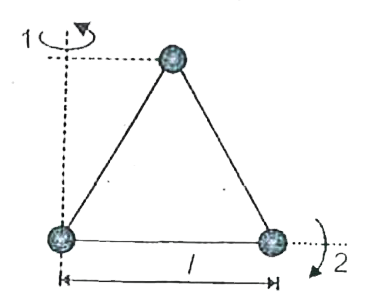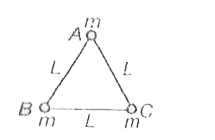Three particles each of mass m are arranged at the corners of an equililateral triangle of side L. If one of masses is doubled. The shift in the centre of mass of the system
L√3
L4√3
√3L4
L2√3
The correct Answer is:B
To solve the problem of finding the shift in the center of mass when one of the masses at the corners of an equilateral triangle is doubled, we can follow these steps:
Step 1: Understand the Initial Configuration
We have three particles, each of mass m, located at the corners of an equilateral triangle with side length L. Let’s denote the positions of the particles as follows:
- Particle A at (0, 0)
- Particle B at (L, 0)
- Particle C at \((\frac{L}{2}, \frac{L\sqrt{3}}{2})\)
Step 2: Calculate the Initial Center of Mass
The center of mass (CM) of a system of particles is given by the formula:
\(
\text{CM} = \frac{1}{M} \sum m_i \vec{r_i}
\)
where \(M\) is the total mass and \(\vec{r_i}\) is the position vector of each mass.
The total mass \(M\) of the system is:
\(
M = m + m + m = 3m
\)
Now, we calculate the coordinates of the center of mass:
\(
x_{CM} = \frac{1}{3m} \left( m \cdot 0 + m \cdot L + m \cdot \frac{L}{2} \right) = \frac{1}{3} \left( 0 + L + \frac{L}{2} \right) = \frac{1}{3} \left( \frac{3L}{2} \right) = \frac{L}{2}
\)
\(
y_{CM} = \frac{1}{3m} \left( m \cdot 0 + m \cdot 0 + m \cdot \frac{L\sqrt{3}}{2} \right) = \frac{1}{3} \left( 0 + 0 + \frac{L\sqrt{3}}{2} \right) = \frac{L\sqrt{3}}{6}
\)
Thus, the initial center of mass is at:
\(
\text{CM}_{initial} = \left( \frac{L}{2}, \frac{L\sqrt{3}}{6} \right)
\)
Step 3: Modify the Mass of One Particle
Now, let’s double the mass of particle A. The new mass configuration is:
- Particle A: \(2m\)
- Particle B: \(m\)
- Particle C: \(m\)
Step 4: Calculate the New Center of Mass
The new total mass \(M'\) is:
\(
M' = 2m + m + m = 4m
\)
Now, we calculate the new coordinates of the center of mass:
\(
x_{CM}' = \frac{1}{4m} \left( 2m \cdot 0 + m \cdot L + m \cdot \frac{L}{2} \right) = \frac{1}{4} \left( 0 + L + \frac{L}{2} \right) = \frac{1}{4} \left( \frac{3L}{2} \right) = \frac{3L}{8}
\)
\(
y_{CM}' = \frac{1}{4m} \left( 2m \cdot 0 + m \cdot 0 + m \cdot \frac{L\sqrt{3}}{2} \right) = \frac{1}{4} \left( 0 + 0 + \frac{L\sqrt{3}}{2} \right) = \frac{L\sqrt{3}}{8}
\)
Thus, the new center of mass is at:
\(
\text{CM}_{new} = \left( \frac{3L}{8}, \frac{L\sqrt{3}}{8} \right)
\)
Step 5: Calculate the Shift in Center of Mass
The shift in the center of mass can be calculated as:
\(
\Delta x = x_{CM}' - x_{CM} = \frac{3L}{8} - \frac{L}{2} = \frac{3L}{8} - \frac{4L}{8} = -\frac{L}{8}
\)
\(
\Delta y = y_{CM}' - y_{CM} = \frac{L\sqrt{3}}{8} - \frac{L\sqrt{3}}{6}
\)
To find a common denominator (24):
\(
\Delta y = \frac{3L\sqrt{3}}{24} - \frac{4L\sqrt{3}}{24} = -\frac{L\sqrt{3}}{24}
\)
Final Result
The shift in the center of mass is:
\(
\Delta \text{CM} = \left( -\frac{L}{8}, -\frac{L\sqrt{3}}{24} \right)
\)
We have three particles, each of mass m, located at the corners of an equilateral triangle with side length L. Let’s denote the positions of the particles as follows:
- Particle A at (0, 0)
- Particle B at (L, 0)
- Particle C at \((\frac{L}{2}, \frac{L\sqrt{3}}{2})\)
The center of mass (CM) of a system of particles is given by the formula:
\(
\text{CM} = \frac{1}{M} \sum m_i \vec{r_i}
\)
where \(M\) is the total mass and \(\vec{r_i}\) is the position vector of each mass.
\(
M = m + m + m = 3m
\)
\(
x_{CM} = \frac{1}{3m} \left( m \cdot 0 + m \cdot L + m \cdot \frac{L}{2} \right) = \frac{1}{3} \left( 0 + L + \frac{L}{2} \right) = \frac{1}{3} \left( \frac{3L}{2} \right) = \frac{L}{2}
\)
y_{CM} = \frac{1}{3m} \left( m \cdot 0 + m \cdot 0 + m \cdot \frac{L\sqrt{3}}{2} \right) = \frac{1}{3} \left( 0 + 0 + \frac{L\sqrt{3}}{2} \right) = \frac{L\sqrt{3}}{6}
\)
\(
\text{CM}_{initial} = \left( \frac{L}{2}, \frac{L\sqrt{3}}{6} \right)
\)
Now, let’s double the mass of particle A. The new mass configuration is:
- Particle A: \(2m\)
- Particle B: \(m\)
- Particle C: \(m\)
The new total mass \(M'\) is:
\(
M' = 2m + m + m = 4m
\)
\(
x_{CM}' = \frac{1}{4m} \left( 2m \cdot 0 + m \cdot L + m \cdot \frac{L}{2} \right) = \frac{1}{4} \left( 0 + L + \frac{L}{2} \right) = \frac{1}{4} \left( \frac{3L}{2} \right) = \frac{3L}{8}
\)
y_{CM}' = \frac{1}{4m} \left( 2m \cdot 0 + m \cdot 0 + m \cdot \frac{L\sqrt{3}}{2} \right) = \frac{1}{4} \left( 0 + 0 + \frac{L\sqrt{3}}{2} \right) = \frac{L\sqrt{3}}{8}
\)
\(
\text{CM}_{new} = \left( \frac{3L}{8}, \frac{L\sqrt{3}}{8} \right)
\)
The shift in the center of mass can be calculated as:
\(
\Delta x = x_{CM}' - x_{CM} = \frac{3L}{8} - \frac{L}{2} = \frac{3L}{8} - \frac{4L}{8} = -\frac{L}{8}
\)
\Delta y = y_{CM}' - y_{CM} = \frac{L\sqrt{3}}{8} - \frac{L\sqrt{3}}{6}
\)
To find a common denominator (24):
\(
\Delta y = \frac{3L\sqrt{3}}{24} - \frac{4L\sqrt{3}}{24} = -\frac{L\sqrt{3}}{24}
\)
The shift in the center of mass is:
\(
\Delta \text{CM} = \left( -\frac{L}{8}, -\frac{L\sqrt{3}}{24} \right)
\)
Topper's Solved these Questions
- SYSTEM OF PARTICLESBOOK - NARAYNACHAPTER - SYSTEM OF PARTICLESEXERCISE - Level-V
72 Videos
- SYSTEM OF PARTICLESBOOK - NARAYNACHAPTER - SYSTEM OF PARTICLESEXERCISE - Level-VI
78 Videos
- SYSTEM OF PARTICLESBOOK - NARAYNACHAPTER - SYSTEM OF PARTICLESEXERCISE - Level -I(H.W)
58 Videos
- PHYSICAL WORLDBOOK - NARAYNACHAPTER - PHYSICAL WORLDEXERCISE - C.U.Q
10 Videos
- SYSTEM OF PARTICLES AND ROTATIONAL MOTION BOOK - NARAYNACHAPTER - SYSTEM OF PARTICLES AND ROTATIONAL MOTION EXERCISE - EXERCISE - IV
39 Videos
Similar Questions
Four identical particles each of mass 1 kg are arranged at the corners of a square of side length 2√2 m.If one of the particles is removed,the shift In the centre of mass is
View SolutionThree particle each of mass m are placed at the corners of equilateral triangle of side l

Which of the following is/are correct ?
View Solution
Knowledge Check
Four identical particles each of mass m are arranged at the corners of a square of side length l. If the masses of the particles at the end of a side are doubled, the shift in the centre of mass of the system.
A0.375mB0.25mC0.125mD0.475mThree particles each of mass 2kg are at the corners of an equilateral triangle of side √3m. If one of the particles is removed, the shift in the centre of mass is
A0.2mB0.5mC0.4mD0.3mSix identical particles each of mass m are arranged at the corners of a regular hexagon of side length L. If the mass of one of the particle is doubled, the shift in the centre of mass is
ALB6L/7CL/7DL√3
Three particles each of mass m are palced at the corners of an equilateral triangle of side b. The gravitational potential energy of the system of particle is
View SolutionThree particles each of mass m are placed at the three corners of an equilateral triangle of side L. A particle of mass M is kept at the midpoint of any one side. What is the force acting on M, due to this system of 3 particles ?
View SolutionThree particles each of mass m are palced at the corners of an equilateral triangle of side b. The gravitational potential energy of the system of particle is
View SolutionThree identical particles each of mass "m" are arranged at the corners of an equiliteral triangle of side "L". If they are to be in equilibrium, the speed with which they must revolve under the influence of one another's gravity in a circular orbit circumscribing the triangle is
View SolutionThree particles A,B and C each of mass m are lying at the corners of an equilateral triangle of side L . If the particle A is released keeping the particles B and C fixed , the magnitude of instantaneous acceleration of A is

View Solution